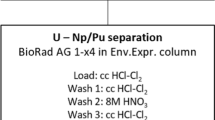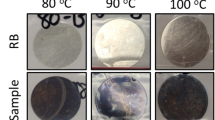Abstract
Two typical methods used for the determination of uranium in human autopsy tissues are kinetic phosphorescence analysis (KPA) and alpha-spectrometry, both of which have significant limitations and advantages. KPA is limited because of the amount of sample used (1–10 ml for sample digestion followed by one ml KPA aliquots), no isotopic information is provided, phosphorescence degradation by salts in solution, and even more importantly, it does not provide chemical recovery information. For samples with sub ng uranium concentrations per g of inorganic material, preconcentration is necessary, which may require chemical recovery (other than simple evaporation). While alpha-spectrometry has very good radiometric detection limits for 238U, the very long half-life of 238U (4.468·109 y) restricts its mass detection limit (27 ng). KPA, on the other hand, has a detection limit three orders of magnitude lower (0.02 ng) for natural uranium. A recovery corrected method for the determination of natural uranium in human tissues was developed combining preconcentration of human tissues dissolved in 6M HCl by anion exchange with alpha-spectrometry and kinetic phosphorescence analysis, utilizing 232U as a tracer. Solution aliquots containing up to 6 g of bone ash were pre-concentrated for KPA measurement thereby allowing the use of up to 25% of the original sample solution weight for analysis by KPA. The radiochemical yield of 232U was determined by alpha-spectrometry and the uranium content was determined by KPA. The mean radiochemical yields obtained for human tissue samples range from 65% to 106% with a mean of 85%±8%.
Similar content being viewed by others
References
E. Brown, R. B. Firestone, V. S. Shirley (Eds), Table of Radioactive Isotopes, John Wiley & Sons, New York, 1986.
A. Mauda, Distribution of Thorium, Uranium and Potassium and Radioactive Heat Production as a Function of Depth of Earth, Rep INSJ-65, Institute of Nuclear Studies, Japan, 1964.
S. Dashenkov, D. Vasdudev, Y. Kapulink, D. Gleba, D. Fleisher, K. Ting, B. Ensley, Environ. Sci. Technol., 31 (1997) 3468.
N. P. Singh, M. E. Wrenn, Metabolism of Minerals and Trace Elements in Human Disease, Chapter 26: The Metabolic and Pathological Aspects of Uranium, Smith-Gordon & Company, London, 1989.
M. Fisenne, P. M. Perry, N. Y. Chu, Health Phys., 44 (1983) 457.
M. D. Wrenn, P. W. Durbin, B. Howard, J. Lipsztein, J. Rundo, E. T. Still, D. L. Willis, Health Phys., 48 (1985) 601.
International Commission on Radiological Protection, Limits for Intakes by Workers, ICRP Publication 30, Pergamon Press, Oxford, 1978.
D. W. Medley, R. L. Kathren, A. G. Miller, Health Phys., 67 (1994) 122.
E. Gonzales, A. Simmons, LA-10300-M, Vol. II, ER320, Kinetic Phosphorescence Analysis (KPA), 1993.
J. F. McInroy, H. A. Boyd, B. C. Eutsler, D. Romero, Health Phys., 49 (1985) 587.
N. P. Singh, D. D. Bennett, M. E. Wrenn, Health Phys., 53 (1987) 261.
D. R. Oden, Jr., Comparison of Alternative Nondestructive Techniques for the Determination of 238U Reaction Rates, BNWL-1637, 1972.
J. T. Elliston, S. E. Glover, R. H. Filby, ANS Trans., 77 (1997) 14.
R. Byrne, L. Benedik, Sci. Total Environ., 107 (1991) 143.
G. Seiler, A. Sigel, H. Sigel (Eds), Handbook on Metals in Clinical and Analytical Chemistry, Chapter 13: Neutron Activation Analysis and γ-Spectrometry, Merkel Dekker, Inc., New York, 1994.
D. W. Boomer, M. J. Powell, Anal. Chem., 59 (1987) 2810.
G. Ting, D. C. Paschal, K. L. Caldwell, J. Anal. Atomic Spect., 11 (1996) 339.
V. Vanhoe, J. Trace Elem. Electrolytes Health Dis., 7 (1993) 131.
United States Transuranium and Uranium Registries Radioanalytical Procedure Manual, USTUR-100: Tissue ashing, sample dissolution, sample aliquot selection, and tracer addition for anion exchange of radionuclides, Washington State University, Pullman, WA, 1996.
Chemchek Instruments, Operation and Service Manual, Chemchek Instruments, Inc., Richland, WA, 1993.
S. G. Schulman, Molecular Luminescence Spectroscopy, Methods and Applications: Part I, Wiley, New York, 1986, p. 376.
A. G. Sowder, S. B. Clark, R. A. Fjeld, J. Radioanal. Nucl. Chem., 234 (1998) 257.
E. Gonzales, LANL RT-100, Tissue Ashing, Sample Dissolution, Sample Aliquot Selection, and Tracer Addition for Anion Exchange of Radionuclides, 1986.
United States Transuranium and Uranium Registries Radioanalytical Procedure Manual, USTUR-400: Anion Exchange Isolation of Uranium from Prepared Tissues, Washington State University, Pullman, WA, 1996.
W. D. Ehman, D. E. Vance, Radiochemistry and Nuclear Methods of Analysis, John Wiley & Sons, New York, 1991.
R. L. Kathren, United States Transuranium and Uranium Registries, Annual Report October 1, 1995-September 30, 1996, 1997, p. 59.
Author information
Authors and Affiliations
Rights and permissions
About this article
Cite this article
Elliston, J.T., Glover, S.E. & Filby, R.H. The determination of natural uranium in human tissues by recovery corrected kinetic phosphorescence analysis. Journal of Radioanalytical and Nuclear Chemistry 248, 487–491 (2001). https://doi.org/10.1023/A:1010673318710
Issue Date:
DOI: https://doi.org/10.1023/A:1010673318710




